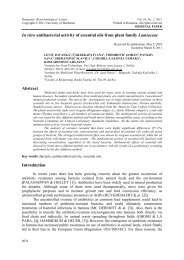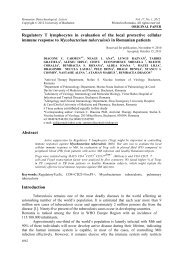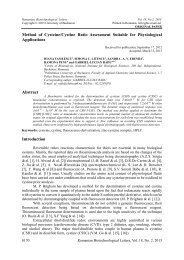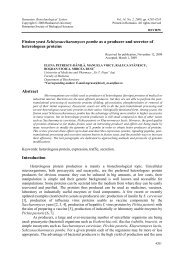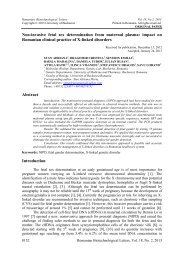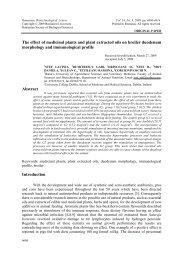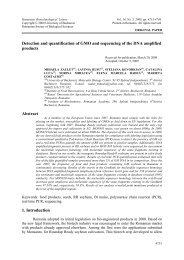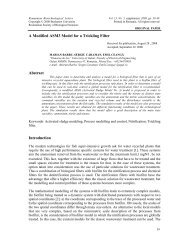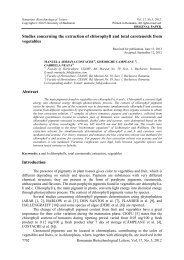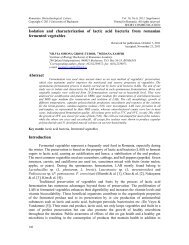In vitro culture initiation and phytohormonal influence ... - Rombio.eu
In vitro culture initiation and phytohormonal influence ... - Rombio.eu
In vitro culture initiation and phytohormonal influence ... - Rombio.eu
Create successful ePaper yourself
Turn your PDF publications into a flip-book with our unique Google optimized e-Paper software.
Romanian Biotechnological Letters Vol. 15, No.1, Supplement, 2010<br />
Copyright © 2010 University of Bucharest<br />
Printed in Romania. All rights reserved<br />
ORIGINAL PAPER<br />
<strong>In</strong> <strong>vitro</strong> <strong>culture</strong> <strong>initiation</strong> <strong>and</strong> <strong>phytohormonal</strong> <strong>influence</strong><br />
on Dianthus henteri – a Romanian endemic species<br />
Abstract<br />
Received for publication, November 10, 2009<br />
Accepted, February 8, 2010<br />
VICTORIA CRISTEA 1 , ALEXANDRA-TIMEA BRUMMER 2 ,<br />
LILIANA JARDA 1 , MIHAI MICLĂUŞ 3<br />
1” Babeş-Bolyai” University, “Alex<strong>and</strong>ru Borza” Botanical Garden, phone/fax: 0264.592152,<br />
E-mail: victoria.cristea@ubbcluj.ro<br />
2 ” Babeş-Bolyai” University, Faculty of Biology <strong>and</strong> Geology, Republicii<br />
3<br />
Waksman <strong>In</strong>stitute of Microbiology, Rutgers University<br />
The biotechnology of in <strong>vitro</strong> <strong>culture</strong> plays an important role in the conservation of plant<br />
biodiversity nowadays. <strong>In</strong> <strong>vitro</strong> collections represent a viable alternative for species that have<br />
phytogeographic <strong>and</strong> sozologic importance <strong>and</strong> that are difficult to conserve outdoors. Dianthus<br />
henteri H<strong>eu</strong>ff. ex Griseb. & Schenk (fam. Caryophyllaceae) is a strictly endemic species for the<br />
Meridional branch of the Romanian Carpathians, being threatened nationwide.<br />
The in <strong>vitro</strong> <strong>culture</strong> was initiated from hydrogen peroxide-sterilized seeds. The disinfection<br />
rate was 93.75% <strong>and</strong> 75% of the seeds germinated 15 days after inoculation.<br />
Three media were tested for multiplication <strong>and</strong> three others for rhizogenesis, having different<br />
balances of NAA <strong>and</strong> BAP phytohormones. The best results for multiplication were on NAA 0.1 mg l -1<br />
<strong>and</strong> BAP 1 mg l -1 (hormonal balance 1/10) medium, while the NAA 1 mg l -1 <strong>and</strong> BA 0.1 mg l -1 medium<br />
gave the best results for rhizogenesis (hormonal balance 10/1). 83 days of in <strong>vitro</strong> <strong>culture</strong>s generated<br />
110 to 240 new-explants/inoculum that could further be acclimatized to ex <strong>vitro</strong> conditions.<br />
Keywords: in <strong>vitro</strong> <strong>culture</strong>, Dianthus henteri, micropropagation, rhizogenesis, ex situ conservation<br />
<strong>In</strong>troduction<br />
Nowadays in <strong>vitro</strong> plant tissue <strong>culture</strong>s have a wide range of applications in<br />
biodiversity conservation, among others. Endemic plant species or the ones vulnerable at<br />
different levels – cormophytes in general, but not only – can be multiplied <strong>and</strong> conserved<br />
through aseptic <strong>culture</strong>s. Later on they can be used in repopulating natural sites when this is<br />
considered appropriate. These studies have been initiated in our country in the 90s <strong>and</strong> are<br />
still ongoing now, using the biotechnology of in <strong>vitro</strong> <strong>culture</strong>s.<br />
Dianthus henteri H<strong>eu</strong>ff. ex Griseb. & Schenk (fam. Caryophyllaceae) is a strictly<br />
endemic species for the Romanian Carpathians – the Meridional branch – <strong>and</strong> is also<br />
considered a vulnerable species [16], being threatened nationwide [15]. Studying this species<br />
by means of modern technologies proves to be even more important because it is reported as<br />
missing from the collections of all botanical gardens in the country. Due to the fact that it is a<br />
mountainous species, its maintenance on the rocks of the botanical gardens over time is<br />
difficult, therefore its conservation <strong>and</strong> multiplication through in <strong>vitro</strong> <strong>culture</strong>s is of great<br />
interest.<br />
This biotechnology has already been used for in <strong>vitro</strong> micropropagation <strong>and</strong><br />
conservation of other Romanian or European Dianthus species [1, 2, 4, 7-11, 14, 19] but<br />
studies regarding the in <strong>vitro</strong> conservation of D. henteri have not been undertaken yet.<br />
This paper presents the results we have regarding the multiplication <strong>and</strong> rhizogenesis<br />
for this species, after its in <strong>vitro</strong> induction.<br />
25
<strong>In</strong> <strong>vitro</strong> <strong>culture</strong> <strong>initiation</strong> <strong>and</strong> <strong>phytohormonal</strong> <strong>influence</strong> on Dianthus henteri – a Romanian endemic species<br />
Materials <strong>and</strong> methods<br />
Vegetal material<br />
<strong>In</strong> <strong>vitro</strong> <strong>culture</strong> was initiated with seeds (code XX-0-M-2004/1268) from the<br />
München Botanical Garden Nymphenburg, harvested in 2006.<br />
Seed disinfection<br />
A 13 h pre-sterilization with 4% H 2 O 2 was done initially. H 2 O 2 plays the double role<br />
of being a good sterilizing agent but also getting the seeds out of dormancy. The sterilization<br />
itself was done with 96% ethanol – 2 min – followed by 10% H 2 O 2 – 19 min.<br />
Culture media<br />
A basal Murashige-Skoog media (macro- <strong>and</strong> microelements, <strong>and</strong> FeEDTA) was used<br />
for germinating the sterilized seeds, supplemented with thiamine, pyridoxine, <strong>and</strong> nicotinic<br />
acid, 1 mg l -1 each, myo-inositol 100 mg l -1 , sucrose 30 g l -1 <strong>and</strong> agar 8 g l -1 . Gibberellic acid<br />
(GA 3 ) 100 mg l -1 was either added or not to the above medium (Table 2). GA 3 is known as a<br />
phytohormone playing a role in getting the seeds out of dormancy. It was added using a<br />
Millipore filter after autoclaving the <strong>culture</strong> media.<br />
For the multiplication <strong>and</strong> rhizogenesis experiments same media as above were supplemented<br />
with auxin (α-naphthalene acetic acid – NAA) <strong>and</strong> cytokinin (6-benzylaminopurine - BAP) is<br />
the different <strong>phytohormonal</strong> variants presented in Table 1.<br />
Table 1. Phytohormonal content of <strong>culture</strong> media for multiplication <strong>and</strong> rhizogenesis<br />
Medium Hormonal balance Phytohormones (mg l -1 )<br />
variants (auxin/cytokinin) NAA BAP<br />
For multiplication<br />
V1 0/1 0 1<br />
V2 1/1 1 1<br />
V3 1/10 0.1 1<br />
For rhizogenesis<br />
V4 1/0 1 0<br />
V5 1/1 1 1<br />
V6 10/1 1 0.1<br />
Culture conditions <strong>and</strong> studied parameters<br />
Half of the inoculated seeds were kept in light <strong>and</strong> the other half in darkness, in the<br />
growth chamber, which had a 16 h light/8 h dark photoperiod, 90 µmol m -2 s light intensity,<br />
<strong>and</strong> 25±2°C.<br />
<strong>In</strong>fection <strong>and</strong> germination rates were measured 15 days after inoculation. From the generated<br />
neo-plantlets, apical <strong>and</strong> nodal explants were transferred on the 3 multiplication media<br />
variants, observations being conducted at 44 <strong>and</strong> 83 days after transfer. The <strong>influence</strong> of the<br />
hormonal balance on the length of the generated neo-plantlets <strong>and</strong> the number of neoplantlets/inoculum<br />
was recorded. Later on, uni-nodal explants from these neo-plantlets were<br />
transferred on the 3 media variants for rhizogenesis. Observations were then recorded at 29<br />
<strong>and</strong> 60 days after inoculation. The multiplication rate, the average length of the roots, <strong>and</strong> the<br />
average number of roots/explant were monitored.<br />
Acclimatization<br />
<strong>In</strong> <strong>vitro</strong> generated plants, with a good radicular system, were planted for<br />
acclimatization in: (i) water-imbibed perlite, (ii) mixture of perlite <strong>and</strong> sterilized soil (50%-<br />
26<br />
Romanian Biotechnological Letters, Vol. 15, No. 1, Supplement (2010)
VICTORIA CRISTEA, ALEXANDRA-TIMEA BRUMMER, LILIANA JARDA, MIHAI MICLĂUŞ<br />
50%) imbibed with Murashige-Skoog macroelements solution, (iii) mixture of perlite <strong>and</strong><br />
sterilized soil (50%-50%) imbibed with water. After potting the plants were sprayed with 1%<br />
paclobutrazol. The pots were initially covered under a transparent hood, to maintain a high<br />
atmospheric humidity, <strong>and</strong> then gradually being uncovered.<br />
Statistical analysis<br />
Statistical analysis was performed using t <strong>and</strong> ANOVA tests, with 95% confidence<br />
intervals. p-values < 0.05 were regarded as indicating statistical significance (*).<br />
Results <strong>and</strong> discussion<br />
<strong>In</strong> <strong>vitro</strong> <strong>culture</strong> induction<br />
Results at 15 days after disinfection <strong>and</strong> inoculation of the seeds on the 2 medium<br />
variants (with <strong>and</strong> without GA 3 ) are presented in Table 2.<br />
Table 2. The germination <strong>and</strong> infection rates of the seeds 15 days after inoculation<br />
Germination Basal medium with GA 3 (100 Basal medium without GA 3<br />
Species conditions<br />
mg l -1 )<br />
% infected % germinated % infected % germinated<br />
Dianthus Light 0 100 0 75<br />
henteri Dark 0 50 25 75<br />
The disinfection method has good results, as seen in Table 2, with a 6.25% infection<br />
rate only. The germination rate was also good, 75% of the seeds germinating 15 days after<br />
inoculation. These results are similar to those recorded for other species of the Dianthus<br />
genus, Centaurea reichenbachii DC, or Aquilegia nigricans Baumg. [2, 3, 5, 10]. <strong>In</strong> <strong>vitro</strong><br />
<strong>culture</strong> <strong>initiation</strong> by means of sterilized seeds is obviously a much easier method than<br />
sterilizing vegetal material [5-7].<br />
The germination rate in light overpassed the one in darkness although the latter one is<br />
considered to stimulate germination.<br />
No differences in the <strong>influence</strong> of GA 3 were noteworthy, maybe because the seeds of<br />
this species were not in physiological dormancy. For other species though, that have a low<br />
germination rate, GA 3 had positive in <strong>vitro</strong> effect [12, 18].<br />
<strong>In</strong> <strong>vitro</strong> multiplication<br />
The results of the biometric measurements at 44 days after the inoculation of the<br />
apical <strong>and</strong> nodal explants on V1, V2, <strong>and</strong> V3 media variants are presented in Fig. 1.<br />
No. neoplants/inoculum<br />
Lengths of neoplants (cm)<br />
8<br />
7<br />
6<br />
5<br />
4<br />
3<br />
2<br />
1<br />
0<br />
V1 V2 V3<br />
Node<br />
Apex<br />
Romanian Biotechnological Letters, Vol. 15, No. 1, Supplement (2010) 27<br />
3.5<br />
3<br />
2.5<br />
2<br />
1.5<br />
1<br />
0.5<br />
0<br />
V1 V2 V3<br />
Node<br />
Apex<br />
A<br />
B<br />
Fig. 1. <strong>In</strong>fluence of hormonal balance at 44 days after inoculation, on three <strong>culture</strong> media for multiplication:<br />
A. number of neo-plantlets; B. length of neo-plantlets. Statistical analysis (t test) shows that there are significant<br />
differences both in the case of the number of neo-plantlets <strong>and</strong> their length, between the two explants used (node<br />
<strong>and</strong> apex): (p=0.0097(**) <strong>and</strong> p=0.0016 (**), respectively
<strong>In</strong> <strong>vitro</strong> <strong>culture</strong> <strong>initiation</strong> <strong>and</strong> <strong>phytohormonal</strong> <strong>influence</strong> on Dianthus henteri – a Romanian endemic species<br />
As shown in Fig.1 A, the greatest number of neo-plantlets – 7.7/apical inoculum <strong>and</strong><br />
6.9/nodal inoculum – was generated on V3 medium, which was the variant containing 10x<br />
more cytokinin compared to auxin. This was in agreement with the expectations when<br />
choosing a media that has a favorable hormonal balance for cytokinins, known to stimulate<br />
cell division <strong>and</strong> the generations of shoots [17]. On V2 medium, where cytokinins have the<br />
same concentration to auxins, worse results were observed, as expected. Apical inoculi have a<br />
better generation rate of neo-plantlets in general. For another taxon of the Dianthus genus - D.<br />
petra<strong>eu</strong>s Waldst. & Kit. ssp. simonkaianus (Péterfi) – a better multiplication rate was<br />
achieved on a medium with 1/1 hormonal balance (NAA 0.5 mg l -1 <strong>and</strong> kinetin (K) 0.5 mg l -1 )<br />
versus a medium with 1/10 hornomal balance (NAA 0.05 mg l -1 <strong>and</strong> BAP 0.5 mg l -1 ) but in<br />
this instance the cytokinins on the 2 variants are different <strong>and</strong> K is often preferred to BA [11].<br />
<strong>In</strong> the latter case, although the hormonal balance favors cytokinins, auxin concentration is<br />
very low.<br />
V1 <strong>and</strong> V3 media were also better for the length of the neo-plantlets (Fig. 1) meaning<br />
that more cytokinin leads to better results for this parameter, too. The average length of nodal<br />
inoculi was 3.2 cm on V1 <strong>and</strong> 2.9 cm on V3, respectively. Regarding the generation rate of<br />
neo-plantlets/inoculum, the apical explants gave better results than the nodal ones (Fig. 1 A)<br />
while for the length of neoplantlets (Fig. 1B), nodal explants gave better results compared to<br />
the apical ones. For other endemic/vulnerable Dianthus species, from Romania or other<br />
regions of Europe (D. glacialis Haenke ssp. gelidus Schott, Nyman & Kotschy, Dianthus<br />
spiculifolius Schur, Dianthus gigant<strong>eu</strong>s D’Urv., Dianthus gigant<strong>eu</strong>s D’Urv. ssp. banaticus<br />
(H<strong>eu</strong>ff.) Tutin, Dianthus alpinus L., Dianthus gratianopolitanus Vill., Dianthus ferrugin<strong>eu</strong>s<br />
Mill., Dianthus gallicus Pers.) the nodes have a better multiplication rate than the apexes<br />
while the latter ones have a better rhizogenesis compared to the nodes [5]. <strong>In</strong>terestingly, no<br />
differences induced by the <strong>phytohormonal</strong> balance on apical inoculi are noted in this case.<br />
The aforementioned results are also shown in Figure 2, with V2 medium giving the lowest<br />
multiplication rate <strong>and</strong> the shortest length for the neo-plantlets, the evolution of the <strong>culture</strong>s<br />
being the same at 44 <strong>and</strong> 71 days after inoculation.<br />
V1 V3 V2<br />
Fig. 2. <strong>In</strong> <strong>vitro</strong> multiplication of D. henteri on 3 different <strong>culture</strong> media, 71 days after inoculation.<br />
28<br />
Romanian Biotechnological Letters, Vol. 15, No. 1, Supplement (2010)
VICTORIA CRISTEA, ALEXANDRA-TIMEA BRUMMER, LILIANA JARDA, MIHAI MICLĂUŞ<br />
Because the aim of in <strong>vitro</strong> <strong>culture</strong>s is to generate as many explants/initial inoculum<br />
as possible, <strong>and</strong> because the <strong>culture</strong>s still had potential for further development at 44 days,<br />
they were left in the <strong>culture</strong> flasks up to 83 days, having enough space requirements for<br />
growth inside (Fig. 3).<br />
16<br />
14<br />
12<br />
10<br />
8<br />
6<br />
4<br />
2<br />
0<br />
No. neoplants/inoc.<br />
Length of neoplants (cm)<br />
Fig. 3. <strong>In</strong>fluence of hormonal balance on D. henteri multiplication, 83 days after inoculation, on three <strong>culture</strong><br />
media variants. P-values for the ANOVA test show statistically-significant differences among the 3 <strong>culture</strong><br />
media both for the number <strong>and</strong> for the length of the neo-plantlets. p = 0.0002 (***) <strong>and</strong> p = 0.037 (*),<br />
respectively.<br />
As shown in Fig. 3, the evolution trend on the <strong>culture</strong> media was the same even after<br />
doubling the time from inoculation. The greatest number of neo-plantlets was achieved on V3<br />
<strong>and</strong> V1 media, i.e., 16 <strong>and</strong> 11/inoculum, respectively while the lengthiest neo-plantlets were<br />
present on the same V1 <strong>and</strong> V3 media, i.e., 3.6 cm <strong>and</strong> 3.1 cm, respectively.<br />
Analyzing the results of these multiplication experiments we can say that after 83 days, each<br />
neo-plant, having about 10-15 nodes, could generate 110 to 240 new explants, which can be<br />
further replicated. This multiplication rate can be considered as being very satisfactory. We<br />
recommend the use of V3 medium, with NAA 0.1 mg l -1 <strong>and</strong> BAP 1 mg l -1 (1/10 hormonal<br />
balance). This medium proves its value, with great results, in the case of in <strong>vitro</strong><br />
multiplication of D. spiculifolius, as well [4].<br />
D. fruticosus L. has a similar response to the hormonal balance of the <strong>culture</strong> media,<br />
with the best multiplication rate for a 1/5 balance (NAA 0.1mg l -1 <strong>and</strong> isopentenyladenine<br />
(2iP) 0.5 mg l -1 ) [13]. It appears to be a species-specific response to in <strong>vitro</strong> <strong>culture</strong>s though,<br />
with species like D. petra<strong>eu</strong>s W. et K. spp. simonkaianus (Péterfi) Tutin generating 110 neoplantlets/apical<br />
inoculum [11] at a 1/1 balance (IAA 1mg l -1 <strong>and</strong> BAP 1mg l -1 ), following<br />
successive transfers, while for another species, D. pyrenaicus Pourr., even a 1/2 balance<br />
(NAA 0.5mg l -1 <strong>and</strong> BAP 1mg l -1 ) can only generate 4.1 neo-plantlets/inoculum [10]. So, a<br />
species-specific variability inside the Dianthus genus was present regarding its in <strong>vitro</strong><br />
multiplication.<br />
<strong>In</strong> <strong>vitro</strong> rhizogenesis<br />
Having the ex <strong>vitro</strong> acclimatization as a final goal for the in <strong>vitro</strong> generated neoplantlets,<br />
these is required to have a well developed root system. Knowing that an auxin-rich<br />
Romanian Biotechnological Letters, Vol. 15, No. 1, Supplement (2010) 29<br />
V1<br />
V2<br />
V3
<strong>In</strong> <strong>vitro</strong> <strong>culture</strong> <strong>initiation</strong> <strong>and</strong> <strong>phytohormonal</strong> <strong>influence</strong> on Dianthus henteri – a Romanian endemic species<br />
<strong>phytohormonal</strong> balance stimulates rhizogenesis, a second experiment was set up, on <strong>culture</strong><br />
media V4, V5, <strong>and</strong> V6. Table 3 summarizes the results regarding multiplication process on<br />
these 3 media.<br />
Table 3. The <strong>influence</strong> of hormonal balance on multiplication <strong>and</strong> rhizogenesis on D. henteri, 29 days after<br />
inoculation<br />
Phytohormones Hormonal<br />
Multiplication (%)<br />
(mg l -1 ) balance Good<br />
Average Necrotic<br />
(10-30 neopl./inoc.) (5-10 neopl./inoc.)<br />
ANA=1 BA=0 1/0 (V4) 29 18 53<br />
ANA=1 BA=1 1/1 (V5) 43 43 14<br />
ANA=1 BA=0,1 10/1 (V6) 77 18 5<br />
The results for these 3 new <strong>phytohormonal</strong> combinations confirmed the <strong>influence</strong> of<br />
the hormonal balance, noted in the multiplication experiment as well. Thus, on V4 medium<br />
with NAA 1 mg l -1 lacking cytokinin, the number of inoculi with a good or average rate of<br />
multiplication was low, 29% <strong>and</strong> 18% respectively, but still less than a half. On the other<br />
h<strong>and</strong>, the necrotic rate was 53%, so this medium should not be used, at least not for this<br />
species. The best results for multiplication were seen on V6 medium, with a hormonal balance<br />
rich in auxin. 95% of the inoculi grown on this medium generated 5-30 neoplantlets/inoculum,<br />
29 days after inoculation <strong>and</strong> the <strong>culture</strong>s had a good further development<br />
in general. V5 medium, with its balanced composition of hormones, was worse than V6,<br />
having a higher necrotic rate (14%), but still had good results, with 86% of the inoculi<br />
generating neo-plantlets. Still, the number of those generating 10-30 neo-plantlets (i.e., having<br />
a high multiplication rate) was under half of total (43%).<br />
V6 medium (NAA 1 mg l -1 <strong>and</strong> BAP 0.1 mg l -1 ) presented also the best results for<br />
rhizogenesis (Fig. 4, 5). Both at 29 <strong>and</strong> at 60 days after inoculation the number of<br />
roots/inoculum as well as their length was higher for an auxin-rich hormonal balance. On V4<br />
medium, results for rhizogenesis after 60 days were similar to V6, but because of its lack of<br />
cytokinins (Table 3), the multiplication was affected. On V5 medium, with a balanced<br />
hormonal composition, rhizogenesis was absent. Judging on the results of this second<br />
experiment, regarding the in <strong>vitro</strong> multiplication <strong>and</strong> rhizogenesis for D. henteri, we could<br />
conclude that the V6 medium, having 10x more auxin compared to cytokinin, led to a<br />
rhizogenesis that allowed the acclimatization of the neo-plantlets <strong>and</strong> also satisfactory<br />
multiplication.<br />
The results for rhizogenesis fit the ones reported for other species of Dianthus that are<br />
important phytogeographically <strong>and</strong> sozologically. For D. pyrenaicus 2 auxins were tested in<br />
parallel: NAA (1 mg l -1 , same as in this work, <strong>and</strong> IAA (indolilacetic acid) 1 mg l -1 ) [10]. The<br />
authors report that on the media containing IAA the rhizogenesis is better than on the one<br />
with NAA (73.2% rooted inoculi versus 11%). <strong>In</strong> both cases a 1/1 hormonal balance is used.<br />
NAA was used for this present work, instead of IAA, the latter one being photodegradable,<br />
negatively influencing its action during the experiments conducted under light. For D.<br />
spiculifolius though, the <strong>influence</strong> of 2 cytokinins, in different hormonal balances (1/1; 0.4/1;<br />
0.2/1 <strong>and</strong> 0.1/1) was recorded with regard to their effect on rhizogenesis [4]. The best variant<br />
proved to be the 1/1 hormonal balance (NAA mg l -1 <strong>and</strong> K mg l -1 ), i.e. the one with the<br />
highest concentration of auxin. For D. petra<strong>eu</strong>s spp. simonkaianus, the same hormonal<br />
balance of NAA <strong>and</strong> K has the best results, among several others that were tested [11].<br />
30<br />
Romanian Biotechnological Letters, Vol. 15, No. 1, Supplement (2010)
VICTORIA CRISTEA, ALEXANDRA-TIMEA BRUMMER, LILIANA JARDA, MIHAI MICLĂUŞ<br />
9<br />
8<br />
7<br />
6<br />
5<br />
4<br />
3<br />
2<br />
1<br />
0<br />
A B A B<br />
V4<br />
V5<br />
V6<br />
Rhizogenesis after 29 days<br />
Rhizogenesis after 60 days<br />
Legend: A-Length of roots (cm), B-No. of roots/inoculum<br />
Fig. 4. <strong>In</strong>fluence of hormonal balance on rhizogenesis of D. henteri at 29 <strong>and</strong> 60 days after inoculation, on three<br />
media variables. These results are confirmed by p-values that show statistically significant differences among the<br />
3 media at 29 days <strong>and</strong> 60 days, both for the number of roots <strong>and</strong> for their length. (p = 0.0106 (*) for number of<br />
roots at 29 day; p < 0.0001 (***) for length of roots at 29 day; p = 0.0025 (**) for number of rots at 60 day; p =<br />
0.0001 (***) for length of roots at 60 day.<br />
V4<br />
V5<br />
Fig. 5. <strong>In</strong> <strong>vitro</strong> rhizogenesis for D. henteri, on V4, V5, <strong>and</strong> V6 <strong>culture</strong> media, 68 days after inoculation.<br />
<strong>In</strong> the case of D. fruticosus, where the goal was only to induce rhizogenesis, the best<br />
medium is the one containing only auxin (2 mg l -1 indole-3-butyric acid (IBA) [13]. Starting<br />
from the above results, we used a novel medium for our present work, with more elevated<br />
auxin levels in the hormonal balance, leading to an average number of 8.6 roots/inoculum. It’s<br />
noteworthy that for the other studied Dianthus species, rhizogenesis is present even at a 1/1<br />
hormonal balance while in the case of D. henteri 10x more auxins were needed, compared to<br />
cytokinins, for inducing this phenomenon. Therefore a species-specific variability inside the<br />
Dianthus genus was also present for the rhizogenesis process.<br />
Acclimatization<br />
Observations, 12 days after ex <strong>vitro</strong> transplantation of the generated neo-plantlets,<br />
show that the most vigorous plants are the ones acclimatized on water-imbibed perlite (Fig.<br />
6). Water-imbibed perlite-soil mixture also leads to viable plants but that are less vigorous.<br />
The worse results were on perlite-soil mixture, imbibed in <strong>culture</strong> media.<br />
V6<br />
Romanian Biotechnological Letters, Vol. 15, No. 1, Supplement (2010) 31
<strong>In</strong> <strong>vitro</strong> <strong>culture</strong> <strong>initiation</strong> <strong>and</strong> <strong>phytohormonal</strong> <strong>influence</strong> on Dianthus henteri – a Romanian endemic species<br />
A<br />
B<br />
C<br />
Fig. 6. Ex <strong>vitro</strong> acclimatized D. henteri <strong>vitro</strong>plant. A. Plant acclimatizeted on perlite – soil mixture. B. Plants<br />
acclimatizeted on perlit. C. Acclimatized <strong>vitro</strong>plants, in soil, in the greenhouse.<br />
Studies of somaclonal variation as a result of in <strong>vitro</strong> <strong>culture</strong> are underway, using<br />
RAPD <strong>and</strong> SSR markers. Results will show if the <strong>culture</strong> conditions induced any genetic<br />
modification in the vegetal material. Based on the kind of phytohormones used, their<br />
concentration, <strong>and</strong> other studies on various species, it seems most likely that this species will<br />
not display any somaclonal variations either, that are due to its micropropagation. After<br />
confirming that the vegetal material is not genetically modified, in situ repopulation could<br />
proceed, when required.<br />
Conclusions<br />
D. henteri, strictly endemic for the Meridional branch of the Romanian Carpathians<br />
<strong>and</strong> threatened nationwide, was successfully micropropagated starting from seeds <strong>and</strong> is now<br />
part of the in <strong>vitro</strong> collection of endemic/endangered plants. The best medium for<br />
multiplication had a 1/10 hormonal balance with NAA 0.1 mg l -1 <strong>and</strong> BA 1 mg l -1 . 83 days<br />
after inoculation each neo-plant generated 110 to 240 explants. The best results for<br />
rhizogenesis – 8.6 roots/inoculum – came out of a medium with NAA 1 mg l -1 <strong>and</strong> BAP 0.1<br />
mg l -1 (1/10 hormonal balance). The multiplication rate on this medium was also satisfactory.<br />
<strong>In</strong> <strong>vitro</strong> generated plants were successfully acclimatized. This species behavior in <strong>vitro</strong> was in<br />
close correlation to the hormonal balance of the different media variants that were used.<br />
Aknowledgements<br />
Funding came partially from 31-008/2007 - PNCDI2-Parteneriate, CNMP project.<br />
The authors are thankful to the Biological Research <strong>In</strong>stitute, Cluj-Napoca, for technical<br />
support.<br />
References<br />
1. A. BUTIUC-KEUL, C. DELIU, Rolul unor extracte naturale in multiplicarea in <strong>vitro</strong> la Leontopodium<br />
alpinum Cass. si Dianthus spiculifolius Schur, <strong>In</strong>: D. CACHITA-COSMA, A. BRAVU, A. BREZEANU, eds.,<br />
Actualităţi şi perspective în biotehnologia vegetală, Ed. Ovidius, Constanţa, 2000, pp. 126-134.<br />
2. V. CRISTEA, C. DELIU, B. OLTEAN, A. BUTIUC-KEUL, A. BRUMMER, C. ALBU, G.L. RADU,<br />
oilless <strong>culture</strong>s for pharmac<strong>eu</strong>tical use <strong>and</strong> biodiversity conservation. Acta Hort. (ISHS), 843, 157-164 (2009).<br />
3. V. CRISTEA, M. MICLĂUŞ, C. DELIU, A. HALMAGYI, The micropropagation of some endemic <strong>and</strong> rare<br />
taxa from Gilău – Muntele Mare Massif, Apuseni Mountains, România. Contribuţii Botanice, 39, 201-209 (2004).<br />
32<br />
Romanian Biotechnological Letters, Vol. 15, No. 1, Supplement (2010)
VICTORIA CRISTEA, ALEXANDRA-TIMEA BRUMMER, LILIANA JARDA, MIHAI MICLĂUŞ<br />
4. V. CRISTEA, M. MICLĂUŞ, M. PUŞCAŞ, C. DELIU, <strong>In</strong>fluence of hormone balance <strong>and</strong> in <strong>vitro</strong><br />
photoautotrophy on Dianthus spiculifolius Schur micropropagation. Contribuţii Botanice, 37, 145-153 (2002).<br />
5. V. CRISTEA, M. PUŞCAŞ, M. MICLĂUŞ, C. DELIU, Conservative micropropagation of some endemic or<br />
rare species from the Dianthus genus. Acta Hort., (ISHS), 725, 357-364 (2006).<br />
6. I. HOLOBIUC, R. BLÂNDU, V. CRISTEA, Researches concerning in <strong>vitro</strong> conservation of the rare plant<br />
species Dianthus nardiformis Janka. Biotechnol. & Biotechnol. Eq., 23 (2), 221-224 (2009).<br />
7. I. HOLOBIUC, A. PAUNESCU, R. BLÂNDU, Ex situ conservation using in <strong>vitro</strong> methods in some<br />
Caryophyllaceae plant species from the Red List of vascular plants in Romania. Rom. J. Biol. – Plant Biol., 49-<br />
50, 3-16 (2004-2005).<br />
8. D. KLAVINA, A. GAILITE, G. JAKOBSONE, J. NECAJEVA, , G. GAVRILOVA, Tissue <strong>culture</strong> in<br />
conservation of threatened plant species of Latvia. Acta Universitatis Latviensis, Biology, 676, 183-188 (2004).<br />
9. J. KOVAC, Micropropagation of Dianthus arenarius subsp. bohemicus – an endangered endemic from the<br />
Czech Republic. Botanic Gardens Micropropagation News, 1(8) (1995).<br />
10. D. MARCU, V. CRISTEA, A. BUTIUC KEUL, Micropropagation of Dianthus pyrenaicus Pourr. – endemic<br />
species from Pyrenean Mountains. Contr. Bot., 41(2), 153-159 (2006).<br />
11. M. MICLĂUŞ, V. CRISTEA, C. DELIU, Micropropagation on Dianthus petra<strong>eu</strong>s W. et K. ssp.<br />
simonkaianus (Péterfi) Tutin. Contribuţii Botanice, 38 (1), 77-84 (2003).<br />
12. T. D. NIKAM, R. B. BARMUKH, GA 3 enhances in <strong>vitro</strong> seed germination in Santalum album. Seed Science<br />
<strong>and</strong> Technology, 37 (2), 276-280 (2009).<br />
13. M. PAPAFOTIOU, J. STRAGAS, Seed germination <strong>and</strong> in <strong>vitro</strong> propagation of Dianthus fruticosus L.. Acta<br />
Hort.( ISHS), 813, (2009).<br />
14. A. PĂUNESCU, I. HOLOBIUC, Conservation of endemic species Dianthus callizonus Schott&Kotsky<br />
using in <strong>vitro</strong> techniques. Rev. Roum. Biol. – Biol. Veget., 48 (1-2), 3-7 (2003)<br />
15. A. SÂRBU, ed., Arii speciale pentru protectia si conservarea plantelor in România, Victor B Victor,<br />
Bucuresti. 2007.<br />
16. I. SÂRBU, G. NEGREAN, A. OPREA, I. CRISTUREAN, Listele nationale elaborate in conformitate cu<br />
criteriul A al proiectului, A. SÂRBU, coord., Ghid pentru identificarea importantelor arii de protecţie şi<br />
conservare a plantelor din România, Alo, Bucuresti, 2003, pp 39-79.<br />
17. J. STADEN, E., ZAZIMALOVA, E., F., GEORGE, Plant growth regulators II: Cytokinins, their Analogues<br />
<strong>and</strong> Antagonists, E. F. GEORGE, M. A. HALL, G. J. KLERK, eds., Plant propagation by tissue <strong>culture</strong>, 1, 2008,<br />
pp. 205-227.<br />
18. S. TODOROVIC, D. GRUBISIC, Z. GIBA, D. MISIC, R. KONJEVIC, Sucrose effects on in <strong>vitro</strong> fruiting<br />
<strong>and</strong> seed production of Centaurium pulchellum. Biologia Plantarum, 50 (4), 771-774 (2006).<br />
19. M. ZĂPÂRTAN, Specii endemice, rare si ocrotite, conservate prin tehnici de cultura in <strong>vitro</strong> Dianthus<br />
spiculifolius Schur. Analele Univ. Oradea, Biologie, 2, 36-48 (1995).<br />
Romanian Biotechnological Letters, Vol. 15, No. 1, Supplement (2010) 33



